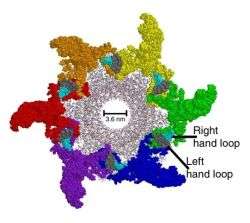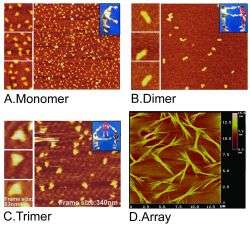No Longer Just For Biology, RNA Can Now Be Built Into 3-D Arrays

Biomaterial to be girders for nanoscale construction projects
Researchers have coaxed RNA to self-assemble into 3-D arrays, a potential backbone for nanotech scaffolds. These RNA structures can form a wider variety of shapes than double-stranded DNA can and are easier to manipulate than many protein alternatives.
Peixuan Guo of Purdue University and his colleagues report the findings in the August 11, 2004, issue of the journal Nano Letters.
RNA (ribonucleic acid) molecules are best known for implementing the genetic information encoded in DNA (deoxyribonucleic acid). However, instead of using the long molecular strings to carry information, the researchers have achieved new control over RNA and created novel arrays.
By mixing the custom-made RNA strands with other substances, such as magnesium chloride, the researchers were able to get the strands to join into 3-D shapes.
In 1987, Guo discovered that a bacteria-infecting virus possesses a biomolecular nanomotor that requires RNA molecules to function. While determining how RNA works in that motor, he learned to manipulate and control RNA assembly.
Now, Guo and his colleagues have applied that knowledge to building artificial RNA nanostructures, including “large” 3-D arrays formed from identical RNA building blocks. Because these arrays extend to several micrometers, far larger than individual RNA strands, they may potentially link nanofabrication with current microfabrication processes.
The researchers hope that the arrays, while still in the earliest stages of development, will one day serve as the scaffolding on which diagnostic chips, tiny sensors, gene delivery vehicles and other nanoscale devices will be mounted or constructed.
From the researchers:
“Living systems contain a wide variety of nanomachines and ordered structures, including motors, pumps and valves. Our research is devoted to making these machines function outside their native environment.” – Peixuan Guo, Purdue University
“We have discovered a particular type of RNA molecule known as pRNA, or packaging RNA, that forms six-unit rings that can drive a tiny but powerful molecular motor.” – Peixuan Guo
“Our future research will focus on incorporating these nanomachines into nanodevices for such applications as drug or gene delivery, gears for nano-equipment, and intricate arrays and chips for diagnostic devices, sensors and electronics.” – Peixuan Guo

“This report demonstrates that RNA can be used to form a variety of artificial shapes and that we can assemble these shapes into arrays tens of microns in size. Using RNA’s tendency to self-assemble, we have built the arrays from many thousands of connected RNA building blocks. The arrays are stable and resistant to a wide range of environmental conditions, such as temperature, salt concentration, and pH.” – Peixuan Guo
From experts at NSF:
“The discovery of this viral RNA machine is quite remarkable and provides yet another example of the flexibility and versatility of RNA. Dr. Guo is exploiting the properties of RNA in a new and potentially important way.” – Patrick Dennis, Program Director for Microbial Genetics at the National Science Foundation and the officer who oversees Dr. Guo’s award.
For more information see:
Peixuan Guo -- Research Homepage: www.vet.purdue.edu/PeixuanGuo/
Source: NSF















